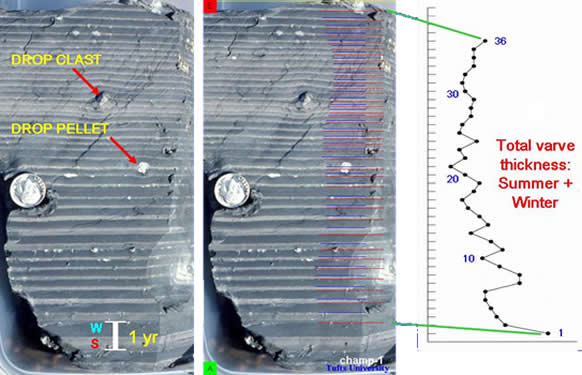The Earth's crust is composed of vast sequences of sedimentary rock layers that contain fossils and structures. This page examines the challenges posed by the geological record to a rapid, global flood.
Introduction: The Geological Column
The Earth's crust is composed of vast sequences of sedimentary rock layers, often thousands of meters thick. These layers, forming the geological column, contain fossils and structures that geologists interpret as a record of Earth's history over millions of years.
Flood geology proposes that the majority of these sedimentary layers were deposited rapidly during the single year of Noah's Flood. However, numerous features within these layers appear inconsistent with such a rapid, catastrophic deposition.
The Challenge:
Can a single, year-long global flood account for the immense thickness, the specific ordering, the delicate structures, and the chemical signatures found within the world's sedimentary rocks?
Varves: Annual Layers
Varves are pairs of sedimentary layers (laminae) that are interpreted as being deposited annually, typically in lakes or quiet marine environments. A common type consists of a lighter, coarser layer deposited during spring/summer runoff and a darker, finer layer deposited during winter when the water body may freeze or be calm.
Formations like the Green River Formation in North America contain millions of such couplets, suggesting deposition over millions of years, not a single year.

Annual sedimentary varves showing distinct layers
The Problem for Flood Geology:
To form millions of distinct layers during a one-year flood would require impossibly rapid, yet perfectly cyclical, deposition rates (multiple layers per second or minute), alternating conditions precisely, without disruption from the supposed global chaotic currents.
Fine Structures & Features
Sedimentary rocks often preserve delicate structures that indicate specific depositional conditions, often requiring time and periods of subaerial exposure (exposure to air) or calm water, seemingly incompatible with a continuous, turbulent flood.
Examples of Fine Structures
- Mud Cracks: Form when wet mud dries out and shrinks, requiring exposure to air. Found preserved within rock layers supposedly deep within the flood sequence.
- Raindrop Imprints: Fossilized impressions of raindrops hitting soft sediment surfaces, also requiring exposure.
- Animal Tracks & Burrows (Trace Fossils): Trails, footprints, and burrows made by organisms living on or in the sediment. Require time for animals to live and move between depositional events. Found throughout the geological column.
- Ripple Marks: Indicate gentle water currents or wave action, not typically the massive energy expected in a global flood.
Implications
The presence of these features *between* layers, and often repeated many times throughout thick rock sequences, suggests numerous cycles of deposition, exposure/calm, and then further deposition over extended periods, rather than one continuous event.
Fossil Sorting
The fossil record exhibits a consistent pattern of faunal succession, where different types of organisms appear in a predictable order through the rock layers. Simpler or more ancient forms are generally found lower down, while more complex or modern forms are found higher up.
A global flood might be expected to produce a largely chaotic mixture of fossils, perhaps sorted crudely by density or hydrodynamic properties, but not the complex and consistent ecological and evolutionary patterns observed globally.
Key Issues:
- Why are flowering plants only found in upper layers, not mixed with ferns and conifers lower down?
- Why are mammals and birds consistently found above dinosaurs, and dinosaurs above trilobites?
- Why aren't humans found mixed in with dinosaurs or trilobites?
(See also: Fossil Record Sorting for a more detailed discussion.)
The observed sorting strongly suggests deposition over long timescales, reflecting the history of life, rather than a single catastrophic burial event.
Geochemical Signatures
The chemical composition of sedimentary rocks also provides clues about their formation environment that challenge the global flood model.
- Paleosols (Fossil Soils): Layers within sedimentary sequences identified as ancient soils, complete with root traces and soil horizons. Soil formation requires stable land surfaces and significant time (hundreds to thousands of years), contradicting continuous flood deposition. Multiple paleosols are often found stacked within sequences attributed to the flood.
- Evaporites: Thick deposits of salt (halite) and gypsum, formed by the evaporation of large bodies of water (like lakes or restricted seas) over long periods. Their presence within the rock record attributed to the flood is problematic, as a global flood involves covering the Earth *with* water, not large-scale evaporation.
- Limestones & Chalks: Many thick limestone and chalk deposits (like the White Cliffs of Dover) are primarily composed of the skeletal remains of trillions of tiny marine organisms (like coccolithophores). Accumulating such vast deposits requires immense biological productivity over long periods in specific marine conditions, not easily reconciled with a turbulent, sediment-laden global flood.
These geochemical and lithological features point to diverse, long-duration processes and environments inconsistent with formation during a single, year-long flood.
Conclusion
The nature of sedimentary layers worldwide presents profound challenges to the hypothesis that they were formed during a single, year-long global flood.
Key challenges include:
- Time Indicators: Features like varves, paleosols, and evaporites suggest processes requiring far more time than one year.
- Environmental Indicators: Delicate structures (mud cracks, tracks), specific rock types (limestones), and geochemical signatures indicate diverse, stable, or exposed environments inconsistent with a continuous global deluge.
- Order vs. Chaos: The consistent sorting of fossils contrasts sharply with the chaotic mixing expected from a catastrophic global event.
While flood geology models attempt to explain these features, the conventional geological interpretation—that sedimentary rocks represent deposition in various environments over vast spans of time—aligns more readily with the physical evidence contained within the rocks themselves.